I’m a huge advocate of SDO – Stitch Dictionary Ownership.
You don’t have to own a gazillion stitch dictionaries. But I do think that every person who goes beyond the initial dabble into embroidery to pursue it as a developing interest should invest in at least one good stitch dictionary.
I won’t go so far as to say in at least two stitch dictionaries, since we have such easy access to the internet and a million online tutorials. But it’s always good to have one, as well as one or more other sources (including online) for cross referencing.
Right now, I have stitch dictionaries piled high and deep on my work table. You’ll find out why later!
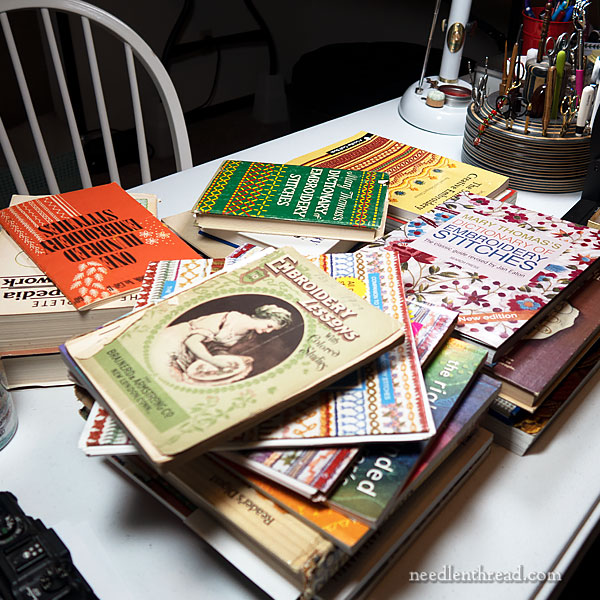
Strangely, these aren’t all of my stitch dictionaries. But these all have Something about them that encouraged me to include them in the pile.
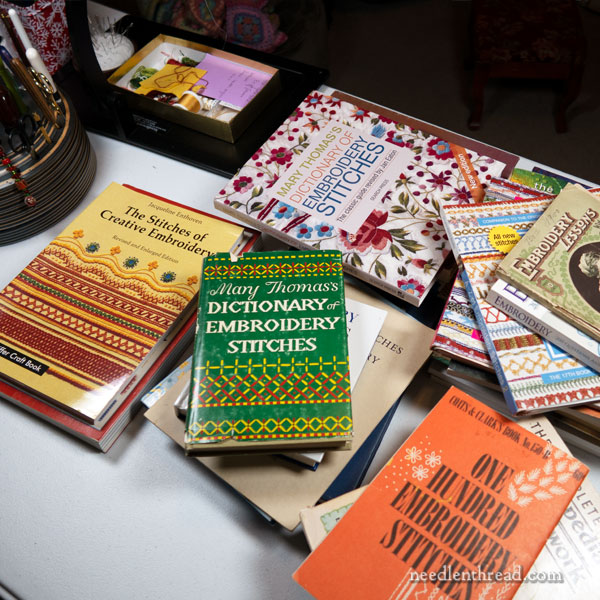
I’m bereaving the absence of two favorites. I either loaned them to someone or I put them somewhere that I wouldn’t forget.
Oh, poo. That never works out!
Why a Stitch Dictionary?
So, my argument – which I’m sure I’ve made before – for owning a stitch dictionary is this:
A real book that you can reference when you need help learning a stitch – or when you need an idea for a stitch for a particular design element you’re working on – is invaluable. Stitch dictionaries are an efficient way to look up a stitch with minimal distraction, and to learn it quickly (usually) from experts who know what they’re doing.
It is true that there are some shoddy stitch dictionaries out there. But the majority of them are from reliable, knowledgeable, talented embroiderers and excellent embroidery teachers.
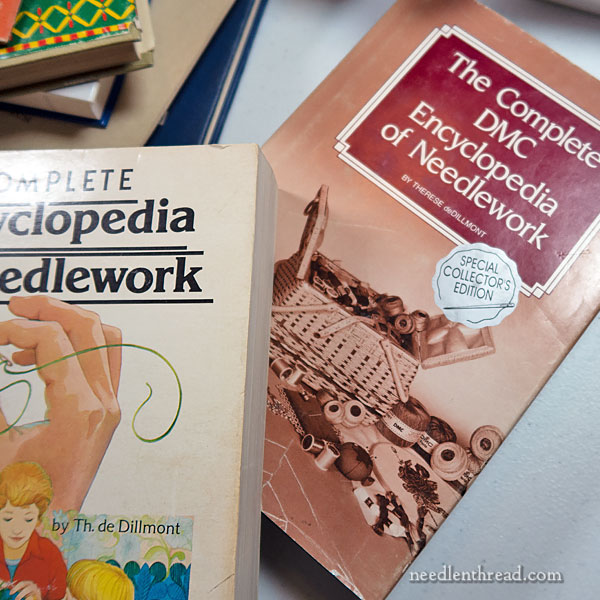
In my collection, I like to have old and new stitch dictionaries, because this helps me cross-reference names and types of stitches, different methods of working them, and different ways they are explained or categorized.
I also like to have new versions of old books, because this helps me see how stitches have developed from one interpretation to another, or how their names have come into more common usage or have dropped out of common usage.
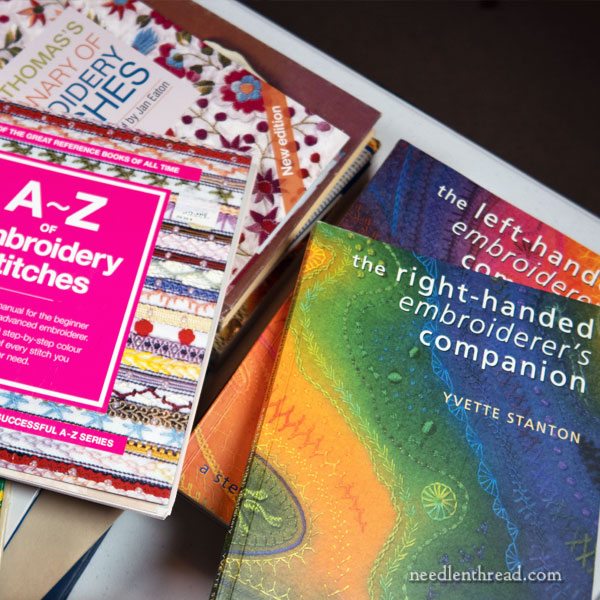
I have many tried-and-true stitch dictionaries…
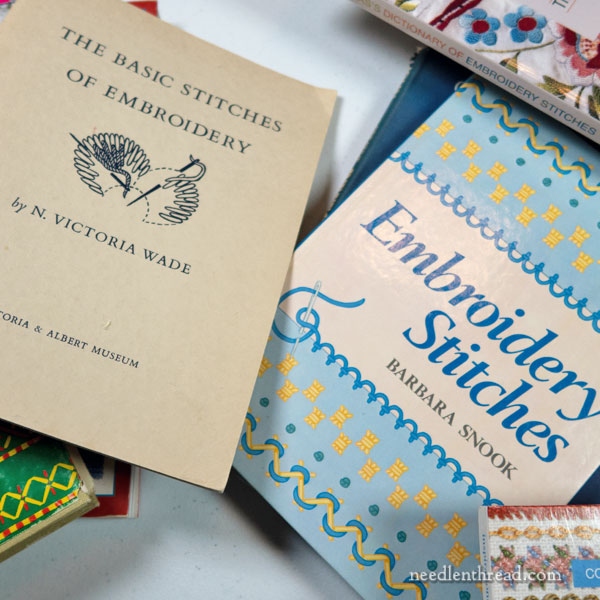
… and many that are obscure and no longer in common usage.
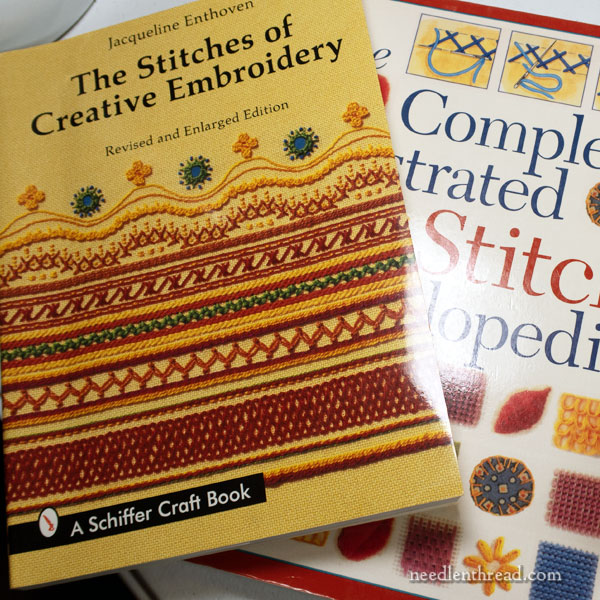
I have conventional and non-conventional stitch dictionaries…
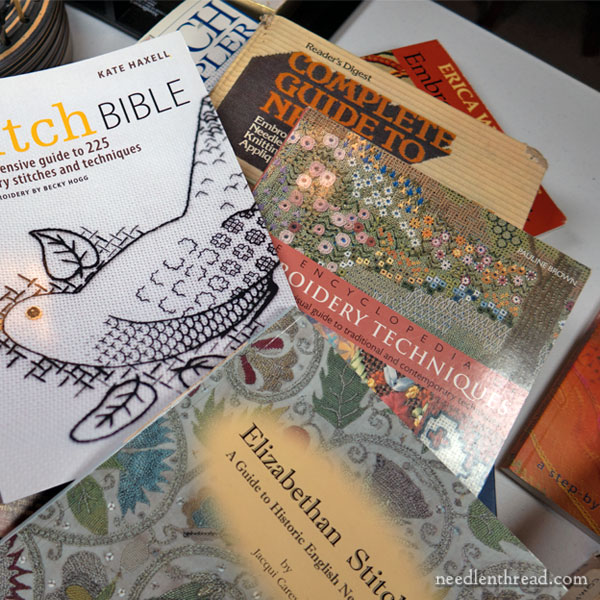
…as well as some that are very specific to eras or techniques.
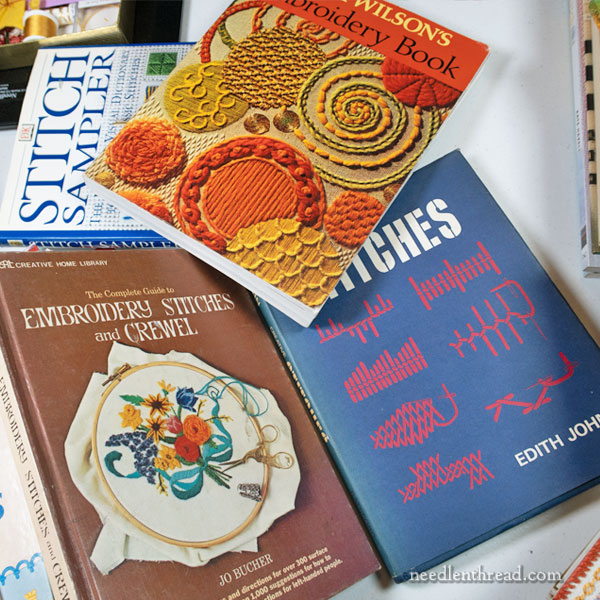
I have many that are old favorites and good friends, that could never go out of date, and many that are outdated but still valuable.
What to Look for in a Stitch Dictionary
It’s hard to say what stitch dictionary will appeal to you. We all have our own preferred learning style. For some, a quick diagram is all it takes. For others, a step-by-step photo explanation works better. For still others, text is a reliable instructor. Some prefer video (hard to come by in books…!) while others prefer photos while still others prefer diagrams and still others have a hard time unless someone is demonstrating for them in person.
So selecting a good stitch dictionary that will suit you best is really something that only you can do.
That said, here some things I look for in contemporary stitch dictionaries that are still being published:
1. A wide variety of stitches…
2. … explained with clear diagrams or photos…
3. … and with well-written and well-edited text, …
4. … all arranged in a logical manner …
5. … and preferably accompanied by images of the finished stitch in context.
Recommended Current Stitch Dictionaries
Here’s a list of recommendations for current stitch dictionaries that are worth looking into, with links to my book reviews so that you can see them in more detail:
Mary Thomas’s Dictionary of Embroidery Stitches – a classic!
Embroidery Stitch Bible – This book has long been a favorite, and I’m happy to say there’s a new edition out, finally.
Yvette Stanton’s Left-Handed Embroiderer’s Companion and Right-Handed Embroiderer’s Companion
The A-Z of Embroidery Stitches and A-Z of Embroidery Stitches 2 (Any of the A-Z books are excellent instructional books, but these are the two that focus on a variety of embroidery stitches rather than on specific techniques)
Lucinda Ganderton’s Embroidery Stitches book – which has come out under a variety of names over the years, depending on where you are and when you bought it. The article explains! I’ve had the older edition called Stitch Sampler for a long time.
You’ll also find some of my favorite stitch dictionaries listed here on my Amazon page, under “Browse my Amazon Favorites,” just in case you’re looking for a stitch dictionary that can be delivered quickly and affordably.
This article contains an affiliate link to my Amazon page. Any purchased you make through that link results in a small commission for Needle ‘n Thread, without any extra cost to you. Thanks!







That’s an enviable collection! I spy several that I have on my shelf too. One of my favourites (and I didn’t see it in your photos…not to say it wasn’t there!) is Judith Baker Montano’s ‘Embroidery & Crazy Quilt Stitch Tool’. It’s a very comprehensive book, giving instruction for both right and left handers, along with being a great small size for tucking into an embroidery bag.
I have her book, Elegant Stitches.
Dear Mary
Thank you for the list of stitch dictionary recommendations very useful to know about the books and where to purchase them. I one of those people who like to watch videos and see how the stitch is accomplished from start to finish, which is why I really like your how to videos they are so easy to follow and your instructions are great. But books are also helpful in taking your time and browsing and reading and looking specifically at the photos to learn how a stitch is done. Thank you for sharing with us your stitch dictionary books and for the list of books still in print which are good resources for how to achieve stitches.
Regards Anita Simmance
Definitely my go-to stitch Dictionary is the Left-Handed Embroiderer’s Companion, first and foremost because I am left-handed, but it is also clear, concise, well-organized and comprehensive. I have yet to see a stitch mentioned and failed to find clear instructions for it in that book. My other favorite from long ago is a small plastic comb-bound compendium of compound stitches called, Crazy Quilt Stitches by Dorothy Bond, which I see is highly prized Amazon, Etsy, etc. With good reason.
Also, your title for today’s post reminded me of one of my all time favorite jokes, told to me by my high school calculus teacher as we were all considering college:
Of course, you all know what B.S. stands for. Well, M.S. is just More of the Same and PhD is just Piled Higher and Deeper.
That joke gives me a giggle every time I think of it.
I’m so glad you find it useful, Kelly!
My favourite is not just an embroidery stitch dictionary, it covers most needlework – I can’t remember the exact title (I’m not in my “library” at the moment). It’s old and it’s by Therese de Dilmont. It’s what started me off on needlepoint lace many moons ago. I also have a Good Housekeeping Encyclopoedia of Needlework which I keep going back to when more modern books don’t give me what I’m looking for. The (we) oldies are the best!
Hi, Ann – it’s in the pictures up there, I think. It’s the Complete Encyclopedia of Needlework by Therese de Dillmont. It’s also been published as DMC’s Complete Encyclopedia of Needlework (she wrote for DMC).
The Good Housekeeping book is great. I have my mother’s copy, which she finally told me I might as well keep because I borrowed it so often. (At least, that’s how I remember it. She may still be waiting for it back.)
It really put me off knitting and, especially, crochet, though. Only recently did I realise crochet didn’t have to look like *that*!
Morning Mary – Just wish I didn’t have to down size and could keep ALL the books I’ve gathered over the last 60 plus years. Most of my fiction books are gone except for a couple of favorite authors. Sometimes you just need to read the page and a kindle is not the same as a book. Cook books shouldn’t be too difficult, there’s a couple from my mum and grandma I’d like to pass on but recipes are so easy to find on-line these days. Next up is the garden theory books. Very last will be my stitching library, including quilting and most of which are just books of patterns anyway. Not as comprehensive as yours to be sure but valued for its content never the less. But before then I just might have to add a couple of the books you’ve recommended in your reviews for the sheer pleasure of looking at the pictures.
Happy reading as you sort through this pile – Brenda
🙁 Downsizing a well-collected and conscientiously considered library of needlework books is a difficult thing to do, that’s for sure!
I see that the Royal School of Needlework is re-releasing their RSN Essential Stitch Guides. Have you had a chance to compare any of the new editions to the old ones?
No, I haven’t, Pat. I don’t know that they will be any different as far as content is concerned. The binding or covers may be different….? I’ll have to wait and see.
Hi Mary, If there is one thing I love as much as needlework, it’s books. I currently have 74 needlework books (I had to make a chart because a couple of times I bought the same book twice!). One of my favorites is a DMC Library Encyclopedia of Needlework by Therese de Dillmont. It is just slightly larger than my hand and over 800 pages. It is quite old but there is no identifying date of publication. Nonetheless, it is a treasure. I’m still adding to my collection as more and more beautiful books are published. Thanks for all you do to keep us stitching!
Is this the little green book? If so, I have it also, and someone wrote in it dating it to 1900-1914 range. I don’t think mine is first edition, because of the line “number of copies issued until now: 750,000” I’m guessing that was in all languages it was printed in.
To JustGail: Sounds like the same book (mine is a light green almost tan), but yours must be older because mine says, “Number of copies issued until now: 1,395,000. “
I love these dictionaries. They keep reminders of how to do the rarely done stitches handy, particularly if I can’t understand the directions as written in a kit or I want to try something new. I also have them for quilt blocks and for knitting and crochet stitches as well. Just reading them has helped improve my ability.
I have a couple books for my go to. Lucinda Ganderton’s Embroidery, Mary Thomas Embroidery Stitches, and Sharon Boggon Creative Stitches. Sometimes I look for inspiration and sometimes just for fun. I have plenty others mostly thanks to you Mary and Amazon that lets me know when there is something I might be interested in. LOL.
I had to smile as I use most of those too!
While it’s that orange covered Erica Wilson book I took with me overseas as a reference for 2 years as a Peace Corps volunteer (& came back determined to learn more about Mountmellick embr’y), you’re missing Marion Nicholas Encyclopedia of Embroidery Stitches Including Crewel, Dover first published in 1974. I like it as illustrations also show what a stitch looks like from back of fabric, and for me a must inclusion is the Portuguese knotted stem and the Palestrina stitch.
Thanks for being such a dependable resource yourself!
It’s there! I just didn’t get a picture of it….
I too have spied several books that I have in my collection. One that I bought recently is Sharon Boggon’s Creative Stitches for Contemporary Embroidery. Sharon is primarily a crazy quilter, er, that is maker of crazy quilts not really crazy herself but this new book is not aimed specifically at crazy quilting and has many variations on standard stitches that I haven’t seen before.
Yes, she is in the stack, too – I had her book by my computer, since I just reviewed it a few weeks ago. Forgot to put it back!
I like the Mary Thomas one except that the diagrams with numbers are really problematic in my copy as the numbers are too faint. In some cases, they are really impossible to read and I’ve had to look the stitch up online and try to figure out the numbering to add in pencilled notes. Otherwise, though, I like it a lot. I especially like that you can look up a stitch by a different name in the index and still find it — something my other go-to book for stitches (which isn’t a stitch dictionary but essentially includes one) doesn’t do. If you can find the stitch, the alternative name is there, but it isn’t really useful by that point.
I prefer diagrams to photos and photos to videos, but diagrams with text seems to work best for me. Don’t know if that’s just because that’s what the first book I used had, though, so I’m used to it — but I really don’t like videos. I want to be able to work the stitch step-by-step with the instructions in front of me and videos don’t work well for that.
I wish there were more Left-handed stitchery books. That old saw about sitting across from a RH stitcher to follow along is ….erm…”nonsense.” Doesn’t work for me or any other lefty I know. We muddle through but would adore a REALLY GOOD stitchery book specifically for us! I do see one in your book pile and will have to see if I can track it down!
Yvette Stanton’s Left-Handed Embroiderer’s Companion is excellent. She’s left handed, and her diagrams and instructions are good and there are a LOT of stitches in the book. Can’t go wrong with any book by Yvette!
I see a few on your shelves that are on mine. And I see a few that look very interesting that I don’t have. I don’t dig into the history like you do, and my shelves are full (over full to be honest) , generally I find myself passing over general stitch dictionaries. Now when I buy stitch dictionaries they tend to be ones for a specific type of needlework.